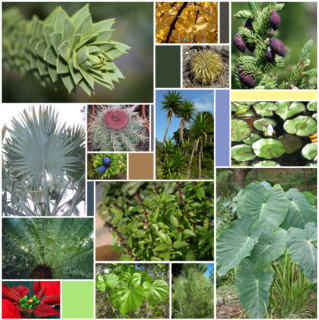
Drosera adelae, commonly known as the lance-leaved sundew, is a carnivorous plant in the genus Drosera that is endemic to Queensland, Australia.

Drosera binata, commonly known as the forked sundew or fork-leaved sundew, is a large, perennial sundew native to Australia and New Zealand. The specific epithet is Latin for "having pairs" - a reference to the leaves, which are dichotomously divided or forked.
Drosera monticola is a perennial carnivorous plant species in the genus Drosera, the sundews. This species is endemic to a single mountain range in Western Australia.
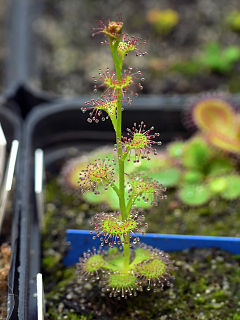
Drosera sect. Stolonifera is a section of ten tuberous perennial species in the genus Drosera that are endemic to south-west Western Australia. The species all have a similar growth habit and all have fan-shaped leaves, but the morphological differences and lack of natural hybrids support the division of the D. stolonifera species complex.

Drosera subg. Ergaleium, collectively known as the tuberous sundews, is a subgenus of three sections of tuberous species in the genus Drosera. The three sections represent natural groups, including the rosetted species, the fan-leaved species, and the erect or scrambling species.

Drosera sect. Erythrorhiza is a section of 14 species of tuberous species in the genus Drosera. It represents a natural group of all the rosetted tuberous Drosera. Most species are endemic to Western Australia, but D. aberrans, D. praefolia, D. schmutzii, and D. whittakeri are also found in eastern Australia.

Drosera bicolor is an erect perennial tuberous species in the genus Drosera that is endemic to Western Australia. It produces a basal rosette of leaves similar to that of D. peltata and the stem grows to 11 cm (4 in) high. Its white flowers that have a red spot near the petal base emerge from September to October. D. bicolor grows in deep silica sand on heathland along the upper Phillips River and south-east of Lake King.

Drosera gigantea, the giant sundew, is an erect perennial tuberous species in the carnivorous plant genus Drosera that is endemic to Western Australia. It grows in sandy soils at the margins of swamps and near granite outcrops along the Western Australian coast from Albany north to just south of Geraldton. D. gigantea produces small shield-shaped leaves along many lateral branches that look like a small tree. Individual plants can grow up to 0.2–1 m (0.7–3.3 ft) tall. Because of its tall, tree-like form, it is considered one of the largest Drosera species. It is also easily cultivated and enjoys damp, humid conditions often provided in greenhouses. White flowers emerge from August to November. The red tubers of this species can grow to be 3.8 cm (1.5 in) in diameter and may be a metre below ground.

Drosera heterophylla, the swamp rainbow, is an erect perennial tuberous species in the carnivorous plant genus Drosera that is endemic to Western Australia. It grows in shallow water swamps or wet clay flats near granite outcrops and occurs in the vicinity of Perth and to its north. D. heterophylla produces small leaves along an erect stem that can be 10–30 cm (4–12 in) tall. It is the only species in the genus that produces many-petaled flowers. These white flowers emerge from June to September.
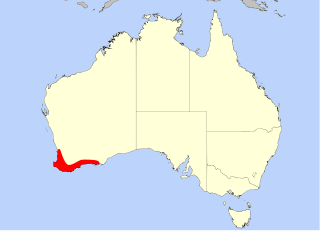
Drosera huegelii, the bold sundew, is an erect perennial tuberous species in the carnivorous plant genus Drosera that is endemic to Western Australia. It grows in sandy soils in winter-wet depressions and margins of swamps and occurs along the south-west coast of Australia. D. huegelii produces small, bell-shaped leaves along an erect stem that can be 10–50 cm (4–20 in) tall. White to cream-coloured flowers emerge from June to September.
Drosera intricata is a scrambling or climbing perennial tuberous species in the carnivorous plant genus Drosera that is endemic to Western Australia. It grows in clay-sand soils on swamp margins, or other habitats that are seasonally wet. D. intricata produces small carnivorous leaves along a glabrous stem that can be 25–40 cm (10–16 in) tall. Its 3-12 yellow flowers emerge from September to October. It gains its species name, intricata, from its twining or winding habit.

Drosera subg. Thelocalyx is a subgenus of two species in the genus Drosera. Both species appear to be very similar and are often confused in cultivation; both have small leaves arranged in a rosette and are annual plants. Their distributions do not overlap, however, with D. burmannii in Southeast Asia and Australia and D. sessilifolia in Brazil, Guyana, and Venezuela.
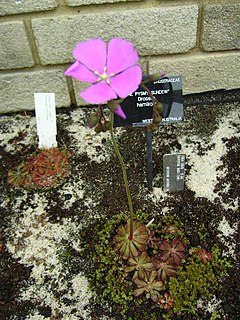
Drosera hamiltonii, the rosy sundew, is a small, compact species in the carnivorous plant genus Drosera and is the only species in the monotypic subgenus Stelogyne. The glandular leaves are about 2 cm (0.8 in) long and arranged in a rosette. In November and December, pink flowers on 30 cm (12 in) tall scapes bloom. It is endemic to coastal swamps in south-west Western Australia. It was first described by Cecil Rollo Payton Andrews in 1903 and placed in section Stelogyne as the only species by Ludwig Diels in 1906. In 1994, Rüdiger Seine and Wilhelm Barthlott suggested D. hamiltonii belonged in their section Drosera, reducing section Stelogyne to synonymy with section Drosera. In 1996, Jan Schlauer revised the genus classification and elevated section Stelogyne to a subgenus, arguing that the unique fused styles requires segregation at more than a sectional rank.

Drosera glanduligera, the pimpernel sundew, is a rosetted annual species in the carnivorous plant genus Drosera that is endemic to Australia. It is 2.5–6 cm (1–2 in) tall and grows in most soil conditions. It produces orange flowers from August to November. It was originally described in 1844 by Johann Georg Christian Lehmann. It is the sole species in the subgenus Coelophylla, which Jan Schlauer elevated from section rank in 1996; it was originally described by Jules Émile Planchon in 1848.
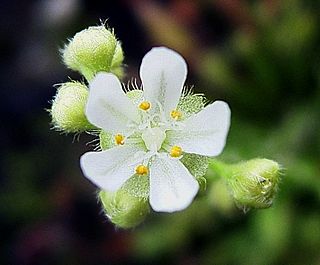
Drosera dilatato-petiolaris is a carnivorous plant in the genus Drosera and is endemic to Australia, being found in both Western Australia and the Northern Territory. Its leaves are arranged in a rosette and commonly produces plantlets, eventually forming large clumps that can be over 1 ft (0.3 m) across. Green petioles emerging from the center of the rosette are typically 3–5 mm wide, but can vary. Red carnivorous leaves at the end of the petioles are small and round, with most resting on the soil surface. Inflorescences are 18 cm (7 in) long with white flowers being produced from April to May. It has a diploid chromosome number of 2n = 12.
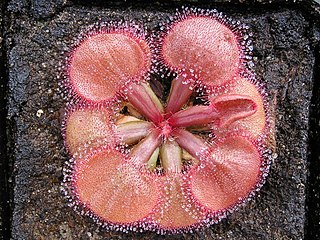
Drosera falconeri is a carnivorous plant in the genus Drosera. It is endemic to the Northern Territory in Australia.
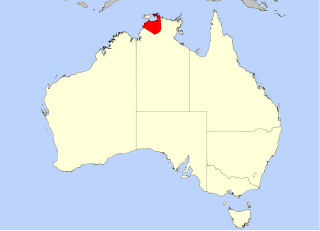
Drosera fulva is a carnivorous plant in the genus Drosera and is endemic to the Northern Territory in Australia. Its semi-erect or prostrate leaves are arranged in a compact basal rosette. Oblanceolate petioles emerging from the center of the rosette are typically 2–3 mm wide at its widest. Red carnivorous leaves at the end of the petioles are small and round at 2–3 mm in diameter. Inflorescences are 25–45 cm (10–18 in) long with white or sometimes pink flowers being produced on 50-or-more-flowered racemes from February to May.

Drosera lanata is a carnivorous plant in the genus Drosera and is endemic to the Northern Territory and Queensland in Australia. Its leaves are arranged in a compact basal rosette. Narrow linear petioles less than 2 mm wide emerge from the center of the rosette and hold carnivorous leaves at the end. Both petioles and the center of the rosette are densely covered in silvery dendritic hairs. These dendritic hairs afford the plant insulation and allow it to trap morning dew for additional moisture during the dry season. The leaf lamina is maroon-red and 2 mm long by 2.5 mm wide.
Drosera zeyheri is a species in the carnivorous plant genus Drosera that is endemic to the Cape Provinces of South Africa. Some botanists treat this species to be a form of D. cistiflora. It differs from typical D. cistiflora specimens by being smaller, sometimes having cauline leaves on the short stems with white, pink, or red flowers. Botanist Fernando Rivadavia has said that he believes of all the forms and varieties in the D. cistiflora complex, D. zeyheri could possibly merit distinction at the species rank. He found it easy to distinguish it from D. cistiflora by its mostly stemless habit, though it often does present one to three leaves on the flower scape. Drosera zeyheri was first described by Terence Macleane Salter in a 1940 volume of the Journal of South African Botany.



